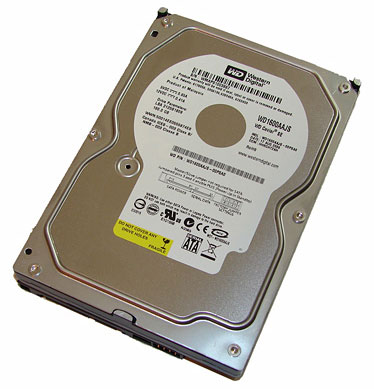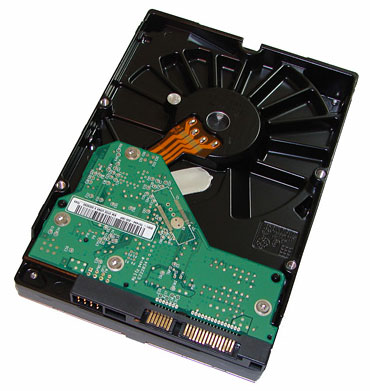Western Digital WD1600AAJS: 160GB Served on Single Platter
by Gary Key on February 5, 2007 11:00 AM EST- Posted in
- Storage
Feature Set: Western Digital Caviar SE 160GB

The external design of the Western Digital SE series is basically the same as other WD offerings but features the standard brushed aluminum faceplate instead of the familiar all black casing on the SE16 and RE2 drives. The drive is based on the industry standard 3.5" form factor platform with pertinent part number and warranty information embossed on a white sticker on the top of the casing.

The new SE family ships with the Serial ATA data and power connectors but drops support for the 4-pin Molex power connector designed for use with older ATX power supplies. The reduced size PCB is openly visible on the bottom of the drive, and as in the previous WD drives the 8MB of cache memory and controller chips are located on the opposite side of the PCB.
To the left of the SATA data and power connectors is an eight-pin jumper block. This jumper block can be utilized to implement spread spectrum clocking or power up in standby operation. This drive ships with SATA 3Gbs operation enabled. While this feature was advantageous for burst transfer rates in our synthetic benchmarks, overall we did not see any measurable improvement in our real world benchmarks. Our test drive was manufactured in Malaysia.

The external design of the Western Digital SE series is basically the same as other WD offerings but features the standard brushed aluminum faceplate instead of the familiar all black casing on the SE16 and RE2 drives. The drive is based on the industry standard 3.5" form factor platform with pertinent part number and warranty information embossed on a white sticker on the top of the casing.

The new SE family ships with the Serial ATA data and power connectors but drops support for the 4-pin Molex power connector designed for use with older ATX power supplies. The reduced size PCB is openly visible on the bottom of the drive, and as in the previous WD drives the 8MB of cache memory and controller chips are located on the opposite side of the PCB.
To the left of the SATA data and power connectors is an eight-pin jumper block. This jumper block can be utilized to implement spread spectrum clocking or power up in standby operation. This drive ships with SATA 3Gbs operation enabled. While this feature was advantageous for burst transfer rates in our synthetic benchmarks, overall we did not see any measurable improvement in our real world benchmarks. Our test drive was manufactured in Malaysia.










18 Comments
View All Comments
semo - Monday, February 5, 2007 - link
Gary, are you thinking of including some ssds (slc and mlc) in the mix for future comparisons. also, are you planning on doing a raid article (again with ssds too) and see if raid edition drives make a difference.Gary Key - Monday, February 5, 2007 - link
Hi,We will have a ssds roundup in March if the products are released on schedule. We will concentrate on SLC first as the MLC drive I do have is just terrible for general desktop usage. It was designed for industrial use and even I would not want to be a user at that workstation. ;) I am working on RAID article for March that will cover several chipsets and drives along with some new benchmarks.
oDii - Monday, February 5, 2007 - link
Gary, would it be possible along side the various chipsets to see how Linux Software RAID performs (http://tldp.org/HOWTO/Software-RAID-HOWTO-5.html">http://tldp.org/HOWTO/Software-RAID-HOWTO-5.html or XFS)? It'd be great to see the results in context, as I haven't been able to find a complete and reliable source of results.semo - Monday, February 5, 2007 - link
thanks!the only reason i wanted to see an mlc drive in a roundup is to get an idea how bad they are but i get the picture now.
i wonder if the faster response of the ssds compensate for their lower transfer rates and beat hdds in general usage. i guess we'll find out in march.
mostlyprudent - Monday, February 5, 2007 - link
I should wait to see some numbers from the versions with 16MB cache sizes, but for me - this article reaffirms my choice of the Seagate 7200.10 320GB.mjz - Monday, February 5, 2007 - link
i'm amazed that the raptor didn't do so good.. why couldn't they just combine the 160 platter with the 10000 rpmDrMrLordX - Tuesday, February 6, 2007 - link
I kinda agree, though the newer 74 gig Raptor w/ 16 meg cache is supposedly faster than the 150 gig Raptor.Personally I'd rather see the 74 gig Raptor in there, but . . .
Gary Key - Tuesday, February 6, 2007 - link
I will have a short performance update to include the 74GB 16MB cache Raptor tomorrow, not a full article but enough results to draw a conclusion.